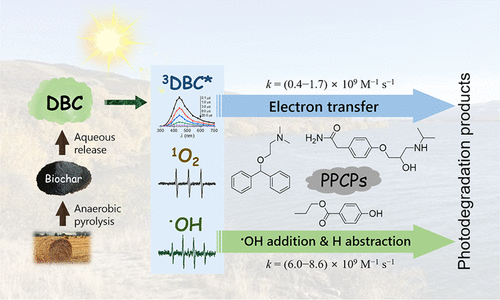当前位置:
X-MOL 学术
›
Environ. Sci. Technol.
›
论文详情
Our official English website, www.x-mol.net, welcomes your
feedback! (Note: you will need to create a separate account there.)
Photogeneration of Reactive Species from Biochar-Derived Dissolved Black Carbon for the Degradation of Amine and Phenolic Pollutants
Environmental Science & Technology ( IF 10.8 ) Pub Date : 2021-06-24 , DOI: 10.1021/acs.est.1c01942 Dong Wan 1 , Jie Wang 1 , Dionysios D Dionysiou 2 , Yaqian Kong 1 , Wanying Yao 1 , Steplinpaulselvin Selvinsimpson 1 , Yong Chen 1
Environmental Science & Technology ( IF 10.8 ) Pub Date : 2021-06-24 , DOI: 10.1021/acs.est.1c01942 Dong Wan 1 , Jie Wang 1 , Dionysios D Dionysiou 2 , Yaqian Kong 1 , Wanying Yao 1 , Steplinpaulselvin Selvinsimpson 1 , Yong Chen 1
Affiliation

|
Due to agricultural waste combustion and large-scale biochar application, biochar-derived dissolved black carbon (DBC) is largely released into surface waters. The photogeneration of reactive species (RS) from DBC plays an important role in organic pollutant degradation. However, the mechanistic interactions between RS and pollutants are poorly understood. Here, we investigated the formation of DBC triplet states (3DBC*), singlet oxygen (1O2), and hydroxyl radical (•OH) in straw biochar-derived DBC solutions and photodegradation of typical pharmaceuticals and personal care products (PPCPs). Laser flash photolysis and electron spin resonance spectrometry showed that DBC exhibited higher RS quantum yields than some well-studied dissolved organic matter. The RS caused rapid degradation of atenolol, diphenhydramine, and propylparaben, selected as target PPCPs in this study. The 3DBC* contributed primarily to the oxidation of selected PPCPs via one-electron-transfer interaction, with average reaction rate constants of 1.15 × 109, 1.41 × 109, and 0.51 × 109 M–1 s–1, respectively. •OH also participated in the degradation and accounted for approximately 2.7, 2.5, and 18.0% of the total removal of atenolol, diphenhydramine, and propylparaben, respectively. Moreover, the photodegradation products were identified using high-resolution mass spectrometry, which further confirmed the electron transfer and •OH oxidation mechanisms. These findings suggest that DBC from the combustion process of agricultural biomass can efficiently induce the photodegradation of organic pollutants under sunlight in aquatic environments.
中文翻译:

生物炭衍生的溶解黑碳活性物质的光生降解胺和酚类污染物
由于农业废弃物燃烧和生物炭的大规模应用,生物炭衍生的溶解黑碳(DBC)大量释放到地表水中。来自 DBC 的活性物质 (RS) 的光生在有机污染物降解中起着重要作用。然而,人们对 RS 和污染物之间的机械相互作用知之甚少。在这里,我们研究了 DBC 三重态 ( 3 DBC*)、单线态氧 ( 1 O 2 ) 和羟基自由基 ( •OH) 在秸秆生物炭衍生的 DBC 溶液中以及典型药物和个人护理产品 (PPCP) 的光降解。激光闪光光解和电子自旋共振光谱法表明,DBC 表现出比一些研究充分的溶解有机物更高的 RS 量子产率。RS 导致阿替洛尔、苯海拉明和对羟基苯甲酸丙酯的快速降解,在本研究中被选为目标 PPCP。的3 DBC *主要促成通过单电子转移相互作用选择的PPCPs的氧化,以1.15×10平均反应速率常数9,1.41×10 9,0.51×10 9中号-1小号-1分别。•OH 也参与了降解,分别约占阿替洛尔、苯海拉明和对羟基苯甲酸丙酯总去除量的 2.7%、2.5% 和 18.0%。此外,使用高分辨率质谱法鉴定了光降解产物,这进一步证实了电子转移和• OH 氧化机制。这些发现表明,来自农业生物质燃烧过程的 DBC 可以有效地诱导水生环境中阳光下有机污染物的光降解。
更新日期:2021-07-06
中文翻译:

生物炭衍生的溶解黑碳活性物质的光生降解胺和酚类污染物
由于农业废弃物燃烧和生物炭的大规模应用,生物炭衍生的溶解黑碳(DBC)大量释放到地表水中。来自 DBC 的活性物质 (RS) 的光生在有机污染物降解中起着重要作用。然而,人们对 RS 和污染物之间的机械相互作用知之甚少。在这里,我们研究了 DBC 三重态 ( 3 DBC*)、单线态氧 ( 1 O 2 ) 和羟基自由基 ( •OH) 在秸秆生物炭衍生的 DBC 溶液中以及典型药物和个人护理产品 (PPCP) 的光降解。激光闪光光解和电子自旋共振光谱法表明,DBC 表现出比一些研究充分的溶解有机物更高的 RS 量子产率。RS 导致阿替洛尔、苯海拉明和对羟基苯甲酸丙酯的快速降解,在本研究中被选为目标 PPCP。的3 DBC *主要促成通过单电子转移相互作用选择的PPCPs的氧化,以1.15×10平均反应速率常数9,1.41×10 9,0.51×10 9中号-1小号-1分别。•OH 也参与了降解,分别约占阿替洛尔、苯海拉明和对羟基苯甲酸丙酯总去除量的 2.7%、2.5% 和 18.0%。此外,使用高分辨率质谱法鉴定了光降解产物,这进一步证实了电子转移和• OH 氧化机制。这些发现表明,来自农业生物质燃烧过程的 DBC 可以有效地诱导水生环境中阳光下有机污染物的光降解。

































 京公网安备 11010802027423号
京公网安备 11010802027423号